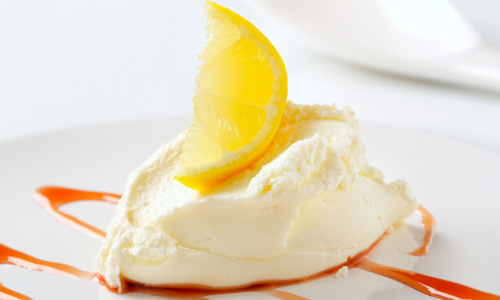
Ingredients for 4 servings:
- 4 white gelatine sheets or 6 g powdered gelatine. (Please follow package instructions.)
- 100 g double cream cheese
- 200 g sour milk
- 125 g sugar
- 75 ml + 1 tbsp lemon juice
- 150 g cream
- 2 tbsp vanilla syrup
- 150 ml pomegranate juice
In addition:
- several lemon slices to garnish
Preparation:
- Soak gelatine in cold water. Beat cream cheese, sour milk and sugar with the whisk attachment of a hand mixer until the mixture is smooth. Add lemon juice only at this point.
- Squeeze out gelatine, dissolve on a low heat. First stir in 3-4 tbsp of the cream and then add gelatine mixture to the remaining cream. Chill for approx. 15 minutes until mixture just begins to set.
- Whip cream and fold into double cream mixture. Chill for approx. 2 hours.
- Heat 1 tablespoon of vanilla syrup. Lightly braise lemon slices in the syrup and then remove. Add remaining vanilla syrup, lemon juice and pomegranate juice. Slightly thicken on a low heat and then let cool again.
- Using 2 tablespoons, cut small dumplings out of the cream. Arrange with drizzles of pomegranate sauce. Serve garnished with lemon slices.
Tip: To cut calories, you can also use a low-calorie variant of the double cream cheese.
Click here for more information on cooking and baking with gelatine.
Approx. nutrition facts per serving:
- Calories: 413
- Joules: 1725
- Protein: 6.3 g
- Fat: 19.8 g
- Carbohydrates: 51.0 g
The Pomegranate – a Veritable Bombshell of Vitamins
The ancient Babylonians already appreciated the value of the red fruit and ate its seeds before setting off into battle to make themselves invincible. The source of this invincibility lies in the wealth of nutrients and vitamins harboured by the red pearls of the pomegranate. Potassium, iron, flavonoids, vitamin C and an abundance of other vitamins make the mildly tart fruit a pleasure to eat and at the same time a boon for the health and the skin.
Preparing the red fruit, however, is an art form in and of itself. Only those who know what they are doing will be able to avoid turning their kitchens into a battlefield. One possibility is extracting the seeds with the fingers or with a spoon. However, in doing so, make sure to remove the white pith with care because this contains the bitter substances. An alternative method is to first remove the stalk and then score the skin along the chambers. Next, break the fruit apart over a bowl. The best trick to use to avoid being splashed by the red juice is, however, breaking the pomegranate apart in a bowl filled with water. The seeds will settle on the bottom of the bowl and the skins and white piths will float to the top.
Pomegranates were originally cultivated in Western and Central Asia. Today, they are also common in the Mediterranean. The ripe fruit is harvested between September and December, after the skins have turned yellowish-red to deep red. What is unusual is that pomegranates do not ripen further after picking, such as bananas or apples do. The seeds of the pomegranate have a tart and fruity flavour. A perfect ingredient for desserts or fruit salads, not least because of their striking dark red colour. However, the translucent seeds also add a refreshing and interesting flavour to hearty dishes. Originally used in oriental cuisine, here, the fruit is increasingly being added to green salads and richly seasoned stews.
In addition to offering a unique flavour sensation, these tart and fruity seeds are also beneficial to the skin. The fruit is rich in vitamins and nutrients, which promote cell renewal, among other things.
Thus it is no wonder that the cosmetic industry has appropriated the active agents of the pomegranate for its products. The antioxidants of the Punica granatum, which is the fruit’s Latin name, work to protect cells and optimise cell metabolism. Pomegranate seed oil is especially good for irritated and dry skin. The fruit extract, on the other hand, works to restore the balance of combination skin, refining pores and helping to make the skin’s overall condition more harmonious. The plant’s flavonoids additionally help prevent skin irritation.
Thus, no matter whether you decide to treat your taste buds or your skin with the valuable constituents of the pomegranate – you can basically do no wrong!